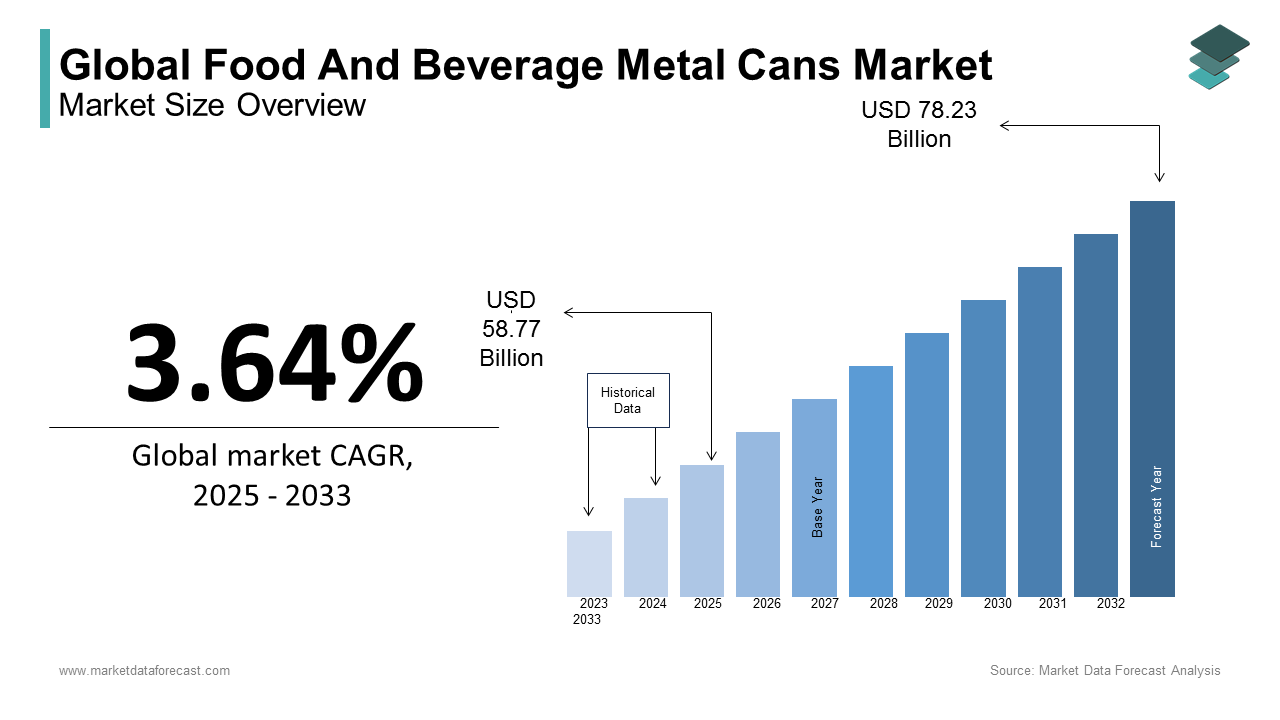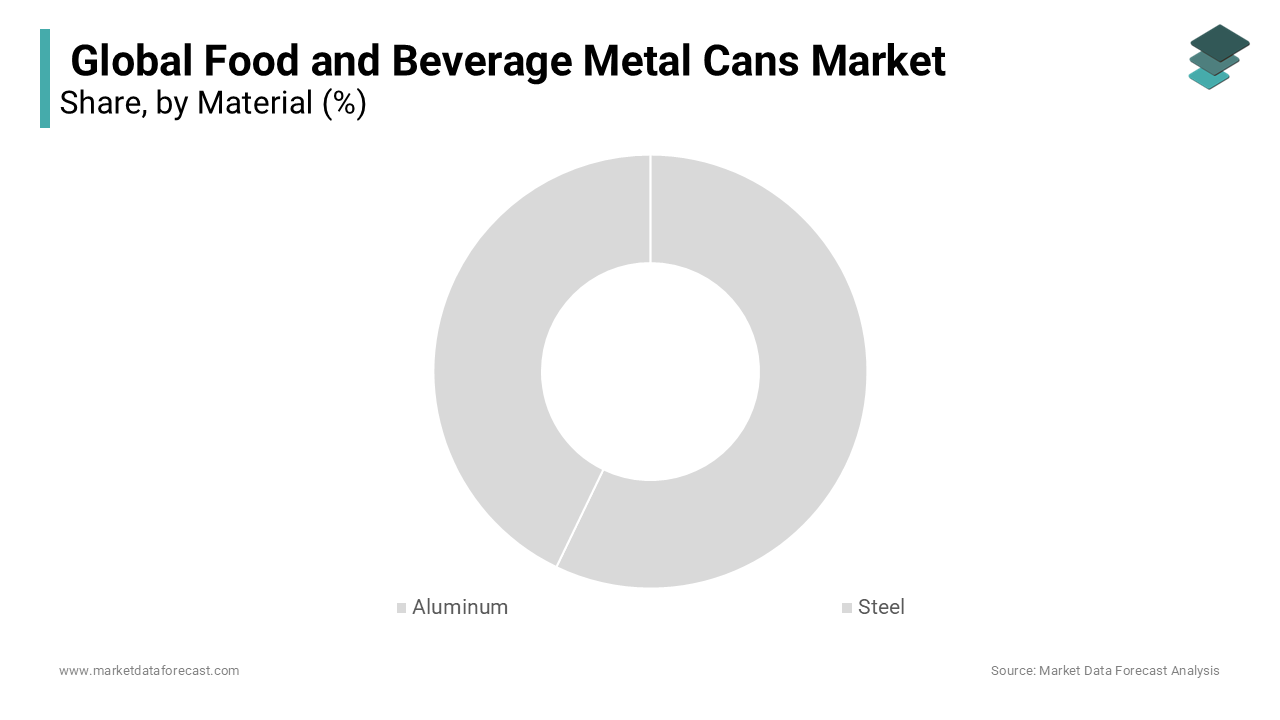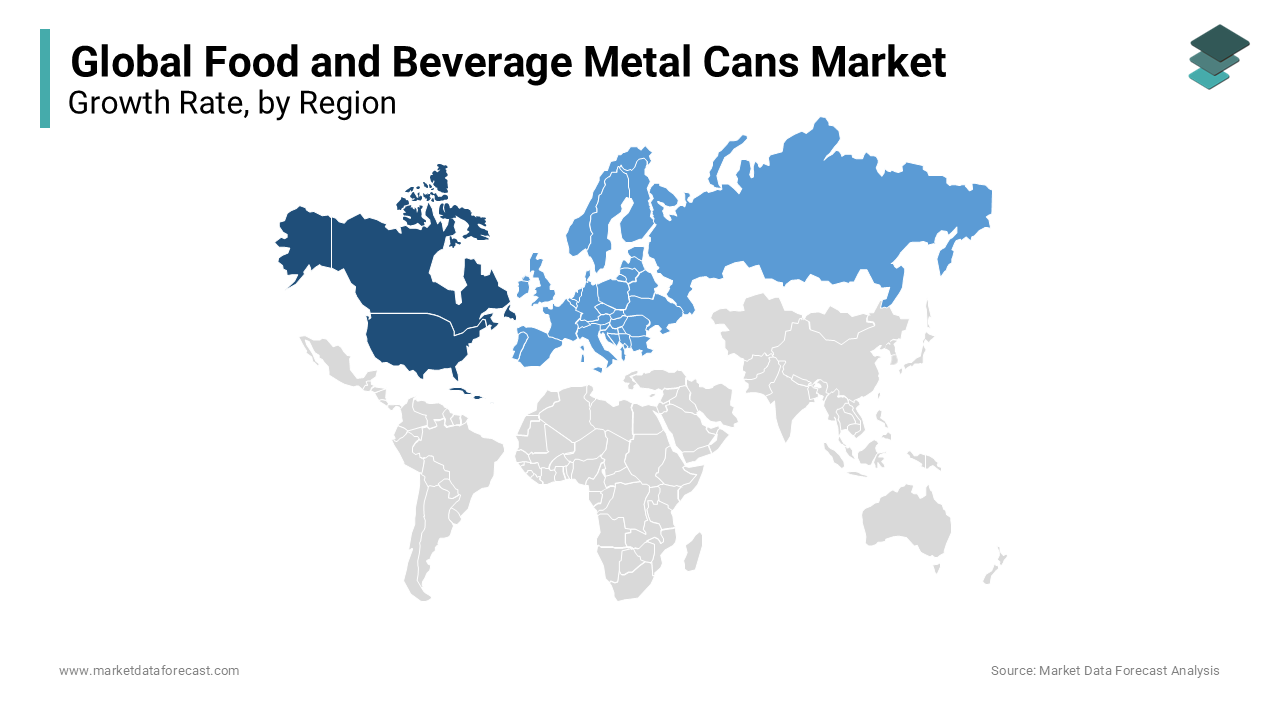Global Food And Beverage Metal Cans Market Size, Share, Trends & Growth Forecast Report – Segmented By Material (Aluminum, Steel), Application (Food, Beverage), Food Can Sub-Application(Fruits And Vegetables, Convenience Food, Pet Food, Meat And Seafood, Other Food Products), Beverage Can Sub-Application( Alcoholic Beverages, Carbonated Soft Drinks, Sports And Energy Drinks, Other Beverages), Beverage Metal Cans Type (2-Piece Cans, 3-Piece Cans), And Region (North America, Europe, Asia Pacific, Latin America, And Middle East & Africa) - Industry Analysis (2025 To 2033)
Global Food And Beverage Metal Cans Market Size
The global food and beverage metal cans market size was calculated to be USD 56.71 billion in 2024 and is anticipated to be worth USD 78.23 billion by 2033 from USD 58.77 billion In 2025, growing at a CAGR of 3.64% during the forecast period. The main advantage is expected to fuel the growth of the Food and Beverage Metal Cans Market during the forecast period.

Food and Beverage Metal Cans are mainly used for food and beverage packaging and were initially introduced in the 19th century. Basically, Food and Beverage Metal Cans were used for wine packaging but then spread to many industrial uses such as oils, chemicals, and food and beverage products. Metal cans are made of aluminum and steel and are used for packaging in various industries. Metal cans are commonly used containers for the distribution and storage of food and beverages. Packaging has essential applications in the packaging of sports and energy drinks, alcoholic beverages, prepared foods, meat and seafood, fruits and vegetables, carbonated soft drinks, and pet food. Metal cans are generally made of aluminum or steel.
The demand for the Food and Beverage Metal Cans Market has increased as the aluminum recycling rate is high, the number of health-conscious consumers increases, and awareness of healthy nutrients in food and beverages increases.
MARKET DRIVERS
Factors such as environmental benefits, the increase in canned goods, and rapid recycling rates are expected to have a positive impact on the metal can industry during the outlook period.
This product stands out for its unique characteristics, such as airtight cover, resistance to transport and irregular handling, and ease of recycling. Aluminum and steel plates are the primary raw materials for the manufacture of products. High availability and ease of use have supported the acceptance of metal cans in the packaging industry. Furthermore, the innovation of the Food and Beverage Metal Cans Market in the manufacturing process, size, and shape has taken the packaging industry to another level. In addition, better preservation and good shelf life have increased the use of metal cans in the food and beverage industry.
The impressive food and beverage industry sales strategy for the purpose of metal cans has had a significant impact on the global market, as it is challenging to review in the latest fashion. Still, it is convenient and economical for users. Product differentiation and the use of green products and practices can also provide tremendous opportunities for market growth. The global market for metal cans for food and beverages has experienced remarkable growth in recent years due to the rapid packaging industry. With the increasing demand for packaged food worldwide, it has been a great stimulus to the world in the last few years. Analysts expect higher disposable income and lifestyle changes to have a positive impact on the global market. The market also benefits from the fact that metal cans can be recycled and reused. Metal cans are used for packaging canned food, pet food, beverages, etc.
The global market for metal cans for food and drink is anticipated to grow significantly during the prediction period. The market is becoming famous due to its full application in the food and beverage industry, and manufacturers are focusing more on tailoring metal cans to prevent contamination and decomposition of food and beverage products. Modernizing consumer lifestyles can have a positive impact on overall market growth during the forecast period. Also, the plastic ban offers a favorable opportunity for the packaging industry. The various coating techniques used in product manufacturing include high-solids coatings, water-based coatings, powder coatings, UV cure coatings, and conventional solvent-mediated coatings. This coating aims to protect the product from wear and oxidation, reduce friction, and improve handling.
MARKET RESTRAINTS
Market growth may be limited if consumer environmental problems with aluminum, iron ore, and other metals increase.
Compared to other alternatives such as paper and plastic, factors such as fluctuations in raw material prices and a lack of microwave capabilities are expected to hamper overall growth in the industry.
REPORT COVERAGE
|
REPORT METRIC |
DETAILS |
|
Market Size Available |
2024 to 2033 |
|
Base Year |
2024 |
|
Forecast Period |
2025 to 2033 |
|
CAGR |
3.64% |
|
Segments Covered |
By Material, Application, Food Can Sub-Application, Beverage Can Sub-Application, Beverage Metal Cans Type And Region |
|
Various Analyses Covered |
Global, Regional and Country Level Analysis; Segment-Level Analysis; DROC; PESTLE Analysis; Porter’s Five Forces Analysis; Competitive Landscape; Analyst Overview of Investment Opportunities |
|
Regions Covered |
North America, Europe, APAC, Latin America, Middle East & Africa |
|
Market Leaders Profiled |
Crown Holdings, Ball Corporation, Silgan Holdings, Ardagh Group, CAN-PACK S.A., Kian Joo Group, CPMC Holdings, Kingcan Holdings Limited, Tetra Laval International S.A., and HUBER Packing Group |
SEGMENTAL ANALYSIS
Global Food and Beverage Metal Cans Market Analysis By Material

The aluminum segment is leading with the highest share of the market. The packaging style and the materials, respectively, play an important role in enhancing the quality of the Food or Beverage by maintaining its aroma for a longer period. Aluminum packaging material is highly effective for packaging due to its lightweight and durable properties, which make food or beverages much more effective and stay fresh for a longer period. It is a non-toxic material that helps preserve food and beverages at an affordable cost. It is one of the more convenient materials to recycle without impacting the environment in a negative way.
The steel segment is likely to have a significant growth rate throughout the forecast period. The growing prominence of high quality and prominent packaging style is majorly fuelling the growth rate of the market. Steel metal cans are 100% safe, whereas food cans do not need an extra layer for protection from corrosion like other materials. This is quietly attributed to elevating the growth rate of the market.
Global Food and Beverage Metal Cans Market Analysis By Application
The beverage segment holds a prominent share of the market, whereas Food has had the fastest growth rate in the past few years. Metal cans are highly used to pack beverages for protection for many long days. It is more likely preferable to cartons and plastic, which is expanding the market’s growth rate to the extent. Rising popularity for ready-to-drink or ready-to-eat food products in a more effective way and preserving them from external contaminants is solely responsible for the growth rate of the market. According to the Pew Research Center, 62% of American adults prefer metal can drinks like alcohol or any other products. The packaging style is what consumers seek to be safe from contamination through external factors.
Global Food and Beverage Metal Cans Market Analysis By Food Can Sub-Application
The convenience food segment is anticipated to hold the highest share of the market in the coming period. Growing disposable income and the rising number of working-class women, even in rural areas, are majorly contributing to the growth rate of the market. The foods that are generally packed in metal have a longer shelf life and maintain their freshness by controlling the external temperature changes. The packaging style helps the food products to not get damaged during transportation and additionally propels the growth rate of the market.
The fruits and vegetables segment is also likely to have potential growth opportunities in the coming years. With high living standards, people mostly seek hygienic food products where the packaging style plays a key role in meeting their preferences, which is likely to drive the growth rate of the market in the coming years.
Global Food and Beverage Metal Cans Market Analysis By Beverage Can Sub-Application
The alcoholic beverages segment is majorly leading the largest share of the food and beverages metal cans market. These beverages need excellent metal cans for perfect storage of freshness with a seal that doesn’t even allow air or moisture that extends the quality of the alcohol products. These metal cans are one of the most effective ways to store alcohol, which is elevating the market’s growth rate.
Also, the growth rate of the carbonated soft drinks market is esteemed to have prominent growth opportunities in the coming years. The sports and energy drinks segment has also gained traction over the share of the market in recent years due to increasing preference for these products from athletes and fitness enthusiasts.
Global Food and Beverage Metal Cans Market Analysis By Beverage Metal Cans Type
2-piece cans are ruling with the largest share of the market, whereas the 3-piece cans segment is getting high opportunities with the rising concern of using only the best quality packaging materials in the F&B industry. Increasing demand for a high number of beverages and food products with the growing population around the world is augmented by the leveling up of the growth rate of the market
REGIONAL ANALYSIS

North America has become the dominant region, accounting for 31.2% of the total share of imports. Increased consumption of beer and other alcoholic beverages is likely to boost the local industry in the projection period. US consumption of frozen and canned foods is assumed to drive market growth during the forecast period. North America and Europe are expected to lose market share in the Asia-Pacific market by contributing to a large part of global beer consumption with China due to emerging markets such as India and China. Furthermore, the increase in meat consumption in China is foreseen to expand market growth during the forecast period further.
Europe was the second largest region, accounting for 30.4% of sales share. Along with European Commission initiatives related to the recycling of chemicals and metals, increased beer consumption is expected to accelerate the growth of the metal can industry during the forecast period. The Asia Pacific area is envisioned to record the fastest growth in the next five years. The increase in disposable income, the availability of different beers at different costs, and the influence of Western culture are determined to increase the demand for beer in Asia. Furthermore, the increase in beer consumption by the young population is probably one of the main factors contributing to the rise in beer consumption in the region, supporting the metal cans business.
KEY PLAYERS IN THE GLOBAL FOOD AND BEVERAGE METAL CANS MARKET
Major Key Players in the Global Food and Beverage Metal Cans Market are Crown Holdings, Ball Corporation, Silgan Holdings, Ardagh Group, CAN-PACK S.A., Kian Joo Group, CPMC Holdings, Kingcan Holdings Limited, Tetra Laval International S.A., and HUBER Packing Group
RECENT HAPPENINGS IN THE MARKET
- Crown Holdings, Inc., in April 2019, declared the launch of shorter, rounded cans on the high-end packaging market. This enabled the company to extend its current portfolio of products.
- Ball Corporation agreed to sell its tin steel aerosol packaging facilities to Envasesdel Plata, a metal packaging company based in Argentina during August 2019. This agreement will help the company expand its business in South America.
- Ball Corporation in October 2019, published the construction of a new aluminum cup manufacturing plant in Rome, Georgia, to meet the growing demand for beverage packaging in the United States. This new plant aids the enterprise to extend its presence in the United States.
- In July 2019, Ardagh Group launched a thin line of 187 ml specially designed to protect wines and wine-based beverages. This launch aims to extend the existing product portfolio of this organization.
- In March 2018, Berlin Packaging acquired H. Erben Ltd., a UK-based supplier of packaging and packaging equipment. The company merged with the Erben acquisition will have a foothold in Europe. The purchase will also help customers and suppliers in Berlin and Erben.
DETAILED SEGMENTATION OF GLOBAL FOOD AND BEVERAGE METAL CANS MARKET INCLUDED IN THIS REPORT
This research report on the global food and beverage metal cans market has been segmented and sub-segmented based on material, application, food can sub-application, beverage can sub-application, beverage metal cans type & region.
By Material
- Aluminum
- Steel
By Application
- Food
- Beverage
By Food can sub-Application
- Fruits & Vegetables
- Convenience Foods
- Pet Food
- Meat and Sea Food
- Other Food Products
By Beverage can sub-Application
- Alcoholic Beverages
- Carbonated Soft Drinks
- Sports and Energy Drinks
- Other Beverages
By Beverage Metal Cans Type
- 2-Piece Cans
- 3-Piece Cans
By Region
- North America
- Europe
- Asia Pacific
- Latin America
- Middle East and Africa
Frequently Asked Questions
1. What are the trends driving the growth of the food and beverage metal cans market?
Some key trends are the increasing demand for convenient and portable packaging, growing awareness and preference for sustainable packaging options, metal can design, and technological innovations such as easy-open lids and resealable features.
2. What are the challenges faced by the food and beverage metal cans market?
Some challenges include competition from alternative packaging materials like plastics and glass, price fluctuations in raw materials such as aluminum and steel, and regulatory requirements related to food safety and packaging standards.
3. How the food and beverage metal cans market expected to is evolve in the future?
The market is expected to witness continued innovation in terms of design, materials, and sustainability. An increased focus on recyclability, lightweight, and convenience features like easy-open lids and microwave-safe cans is anticipated to drive market growth.
Related Reports
Access the study in MULTIPLE FORMATS
Purchase options starting from $ 2500
Didn’t find what you’re looking for?
TALK TO OUR ANALYST TEAM
Need something within your budget?
NO WORRIES! WE GOT YOU COVERED!
Call us on: +1 888 702 9696 (U.S Toll Free)
Write to us: [email protected]